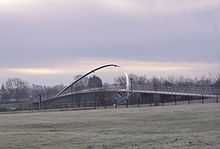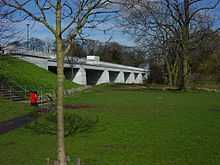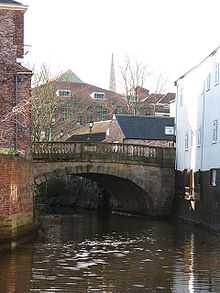Bridges of York
There are nine bridges across the River Ouse within the city of York, England, and sixteen smaller bridges across the narrower River Foss.

Bridges over the Ouse
The earliest bridge, built by the Romans, linked Stonegate (the via praetoria of the Roman fortress) and Micklegate, and crossed the river approximately where the Guildhall now is. Its replacement, Ouse Bridge, was a wooden bridge built about 350 metres downstream by the Vikings. It has been rebuilt three times, most recently between 1810 and 1820. The Scarborough Railway Bridge of 1845 was the second bridge to be built, and it was followed by two more road bridges, Lendal Bridge in 1863 and Skeldergate Bridge in 1882. The Millennium Bridge, a footbridge, was added in 2001. There are also Clifton Bridge in the northern suburbs of the city, two modern fly-overs carrying the outer ring road, and the former railway bridge at Naburn, which is now part of the York-Selby cycle path.
North to south, the bridges are:
- The A1237 road (York Outer Ring Road Western and Northern)
- Clifton Bridge (1963)
- Scarborough Railway Bridge (1844)
- Lendal Bridge (1863)
- Ouse Bridge (1821)
- Skeldergate Bridge (1881)
- Millennium Bridge (2001)
- The A64 Outer Ring Road Southern and Eastern (1976)
- Naburn railway bridge (now a cycle and pedestrian path)
Ouse Bridge

The original Roman bridge over the Ouse was eventually replaced by a wooden bridge built further downstream by the Vikings. In 1154, it collapsed under the weight of a crowd which had gathered to greet St William of York on his return from exile. It was replaced by a stone bridge. In 1367 the first public toilets in Yorkshire, and likely England, were opened on the bridge.[1] Part of the bridge was swept away by floods in the winter of 1564–5. The repaired bridge of 1565 had a new central arch spanning 81 ft, and was described by Defoe as "...near 70 foot [21 m] in diameter; it is, without exception, the greatest in England, some say it's as large as the Rialto at Venice, though I think not." This bridge was dismantled between 1810 and 1818 to make way for the New Ouse Bridge, designed by Peter Atkinson the younger, completed in 1821.[2][3]
Scarborough Railway Bridge

The second bridge across the Ouse was the Scarborough Railway Bridge, built in 1845 to carry the railway line between York and Scarborough (now the Scarborough branch of the North TransPennine route). Originally it had two tracks with a pedestrian path in between them. In 1875 the track was raised 4 feet (1.2 m) and the footpath moved to the south side, where it remains today.
Lendal Bridge

Lendal Bridge stands on the site of a former rope-ferry where the city walls break for the River Ouse. This was the ferry used by Florence Nightingale when she visited York en route to Castle Howard in 1852.
The bridge connects two medieval towers: Lendal Tower on the east bank and Barker Tower on the west bank. It was designed by civil engineer Thomas Page, who also designed London's Westminster Bridge. It is made of cast iron, and has a single span of 53 metres (175ft).[4]
Page's bridge was the second attempt to build a bridge on the site. The first, begun in 1860 by William Dredge, collapsed during construction, and five workmen were killed. Parts of the structure were later taken to Scarborough and used in the Valley Bridge there.[5]
In 1861, permission was obtained from Parliament for a new bridge to be built, and the Corporation of York requested Thomas Page to design a replacement. His Gothic Revival bridge opened in 1863.[6]
Lendal Bridge links Station Road with Museum Street and thus York railway station with York Minster, and is part of York's Inner Ring Road.
Lendal Bridge was used in Damon and Debbie, a 1987 spin-off of soap Brookside for the scenes where long-running character Damon Grant was murdered.
Skeldergate Bridge

Skeldergate Bridge links the York Castle area to the old bailey at Baile Hill. It was designed in a Gothic Revival style by civil engineer George Gordon Page, and built between 1878 and 1881. The small arch at the east end has an opening portion, powered by machinery in the Motor House, which also served as a toll house and accommodation for the toll keeper and his family. The bridge opened to admit tall masted ships to the quays on either side of the river between Skeldergate and Ouse Bridges.[7] Skeldergate Bridge was formally declared free of tolls on 1 April 1914.[8]
Millennium Bridge
Coordinates: 53°56′41.33″N 1°4′55.42″W / 53.9448139°N 1.0820611°W

The Millennium Bridge, built to a competition-winning design by Whitby Bird and Partners,[9] was opened on 10 April 2001, having cost £4.2 million to build. It spans the River Ouse to the south of York, linking Hospital Fields Road and Maple Grove in Fulford with Butcher Terrace on the South Bank. The bridge carries a cycle path and a footpath, and is not open to vehicular traffic. It is a key link in the Sustrans National Cycle Routes 65/66 and is part of the orbital route for York completed in 2011. The bridge shortened the walk or cycle for students from houses in the South Bank to the University of York (they previously had to travel via Skeldergate Bridge).
The bridge also acts a meeting place for local people, as it has a waist height shelf spanning the whole structure which facilitates sitting and admiring the view.Increasingly it is used as a circular walk from the city centre taking in the New Walk on the east bank and Terry Avenue and Rowntree Park on the west bank. While riverside paths regularly flood several times a year the bridge is higher and rarely cut off by floodwaters. Signs on approaches from Fulford Rd /Hospital Fields Rd junction and Butcher Terrace/Bishopthorpe Road warn when it may be impassable without wellies.
At night the bridge is illuminated by banks of lights in different colours, so that the colour of illumination changes every few seconds.
Supplies for Fulford Barracks were brought in by river near this location, and the remains of a narrow gauge railway may be seen on the eastern bank of the river a few metres toward the city. There used to be a rope ferry at this location as well.
-

The Millennium Bridge from Fulford.
-

Below the bridge from Fulford.
-

Millennium Bridge
Naburn Railway Bridge

Outside the outer ring-road, the Naburn bridge used to carry the York-Selby railway until it was diverted in 1983. The bridge now constitutes part of the York & Selby cycle path, connecting the TransPennine trail to York.[10] It is also known as the "Fisherman Bridge" due to a large metal sculpture of a fisherman with bike and dog, sitting on top which was added in 2000 as part of the York Council "Creative Communities 2000" scheme.[11]
Clifton Bridge

A temporary bridge at Clifton was built by the British Army in 1961 on the site of an old ferry crossing to handle additional vehicle traffic caused by the wedding of the Duke and Duchess of Kent at York Minster. A permanent bridge was opened officially on 28 October 1963. The bridge is built from 4,000 tons of concrete and 50 tons of reinforced steel.[12][13]
Bridges over the Foss

South to north, from the confluence with the Ouse, these are:
- The Blue Bridge (1895)
- Castle Mills Bridge (1956), part of York's Inner Ring Road
- Piccadilly Bridge (1911–14)
- Foss Bridge (1811–12)
- Pedestrian bridge linking the Shambles car-park and Rowntree Wharf (c1990)
- Pedestrian bridge north of Rowntree Wharf linking Navigation Road with the Hungate area and Peasholme Green (2011)
- Pedestrian bridge from Foss Islands Road to what is now the Defra site at Peasholme Green (1931)
- Layerthorpe Bridge (1998), carrying Northwestbound Inner Ring Road traffic and traffic between Peasholme Green and Layerthorpe
- Foss Bank Bridge (1998), carrying south-eastbound Inner Ring Road
- Monk Bridge (1794 and later)
- Pedestrian and cycle path bridge, formerly part of the Foss Islands Branch Line of the North Eastern Railway (c1880)
- Fossway Bridge
- Huntington Road Bridge
- Link Road Bridge between Haxby and Huntington
- Church Lane Bridge, Huntington
- The A1237 Outer Ring Road
Many of these are unobtrusive modern bridges carrying main roads. The following are more notable:
Foss Bridge
The Foss Bridge, a single Georgian gritstone arch with balusters, links the streets Fossgate and Walmgate. It is believed that the earliest bridge on this site was constructed during the Viking period. The present bridge, designed by Peter Atkinson the younger and erected in 1811–12, replaced a wooden bridge. The bridge was once the site of a fish market.[3][14]
Pedestrian bridge from Foss island Road to Defra site

This cast-iron pedestrian bridge from Foss Islands Road to what is now the Defra site at Peasholme Green was constructed in 1931 by the Monk Bridge Construction Company to improve communications between York's power station and its cooling tower, both now demolished.[15] It is locked and not in use.
Monk Bridge
Monk Bridge is a single-arched ashlar bridge with a span of approximately six metres. It carries traffic between central York and Heworth and was built in 1794 to designs by Peter Atkinson the elder. In 1924-6, the bridge was widened and the upper part rebuilt.[3]
References
- ↑ http://www.yorkhistory.org.uk/ousebridge.html York History
- ↑ Structurae [en]: Ouse Bridge (1821)
- ↑ 3.0 3.1 3.2 Pevsner, Nikolaus; Neave, David (1995) [1972]. Yorkshire: York and the East Riding (2nd ed.). London: Penguin Books. ISBN 0-14-071061-2.
- ↑ "When Disaster Struck Lendal Bridge". York Press. 11 August 2015. Retrieved 15 April 2015.
- ↑ Brandon, Ed (2013). Curiosities of York (in English). Gloucesershire: Amberley Publishing. ISBN 9781445627717. Retrieved 15 April 2015.
- ↑ "Lendal Bridge". York History. Retrieved 15 April 2015.
- ↑ "Skeldergate Bridge". Yorkshire Gazette. Yorkshire Gazette. 12 March 1881.
- ↑ "Skeldergate Bridge". York History. Retrieved 15 April 2015.
- ↑ Bridge Engineering Analysis: Cast Study: York Millennium Bridge
- ↑ "Trans Pennine Trail". Retrieved 11 September 2012.
- ↑ "Cycle the Solar System". Solar.york.ac.uk. Retrieved 25 January 2014.
- ↑ "Building bridges". York Press. 9 April 2001. Retrieved 25 January 2014.
- ↑ "Spanning the Ouse". York Press. 17 September 2001. Retrieved 25 January 2014.
- ↑ Evans, Antonia (ed) (2002). The York Book. York: Blue Bridge. ISBN 0-9542749-0-3.
- ↑ Mitchell, Vic, and Keith Smith (2003). Branch Line to the Derwent Valley, including the Foss Islands Branch (Map V). Midhurst: Middleton Press. ISBN 1-904474-06-3.
- The Fairest Arch in England: Old Ouse Bridge, York, and its Buildings ISBN 1-874454-26-4
External links
| Wikimedia Commons has media related to Bridges in York. |